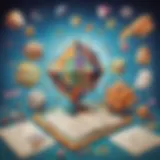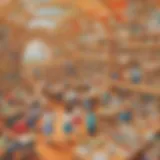Engaging Art Projects to Inspire Fourth Graders


Intro
Art is not just about creating; it's a form of expression that nurtures creativity and imagination in children. For fourth graders, this phase of schooling is crucial as they start to explore their identities and interests. Integrating art into the curriculum can do wonders for their development, offering opportunities to harness their artistic skills. This article dives deep into several innovative art projects especially tailored for these young minds, providing inspiration and guidance for educators, parents, and caregivers.
Creative Activities
Craft Ideas
Craft activities are a delightful way for children to engage with art while enhancing their fine motor skills. Here are a few age-appropriate ideas:
- Paper Mache Animals: Using newspaper and flour paste, kids can construct their favorite animal. When they dry, they can paint them vibrant colors.
- Nature Collage: Gather leaves, petals, and twigs for students to create a stunning collage. This project encourages them to interact with their environment.
- Recycled Art: Encourage them to use old magazines, plastic bottles, and other recyclable materials to create new art pieces. This promotes environmental awareness along with creativity.
Step-by-Step Guides
A clear set of instructions can make all the difference in executing these projects successfully. Let’s take paper mache animals as an example:
- Materials Needed: Newspaper, flour, water, balloon, and paints.
- Preparation: Inflate a balloon and set it on a container to hold it.
- Make the Paste: Mix equal parts of flour and water until smooth.
- Tear and Dip: Tear newspaper into strips, dip them in the paste, and start layering them on the balloon.
- Dry: Allow it to dry completely, usually overnight.
- Paint: Once dried, pop the balloon, and paint the creation.
Educational Value
These art activities do more than just keep kids occupied. They encourage critical thinking, problem-solving, and spatial awareness. Moreover, crafting helps enhance fine motor skills and boosts self-esteem as children see their creations come to life. Art projects can also provide an exciting avenue for collaborative learning, as children often engage in discussions about their choices during the process.
Prelims to Art in Elementary Education
Art in elementary education isn't just about crayons and coloring books; it plays a pivotal role in developing young minds. This section of the article focuses on why integrating art into the curriculum is not just beneficial but necessary for fourth graders.
Importance of Art Education
Art education serves as a vital tool for children's expression and understanding of the world. When kids engage in artistic activities, they don't just learn how to paint or draw; they cultivate essential life skills. These include critical thinking, problem-solving, and emotional intelligence.
Teaching art is more than just creating; it's about fostering an environment where kids can express themselves without fear of judgement.
- Enhances Creativity: Art education encourages students to think outside the box. Creativity isn't reserved for artists alone; it's a skill that can enhance all subjects, from math techniques to scientific inquiry.
- Boosts Confidence: Completing an art project gives a sense of accomplishment. Children learn to trust their instincts and express their opinions, building a strong sense of self-esteem.
- Encourages Cultural Awareness: Exposure to various forms of art from around the world introduces students to different cultures, promoting diversity and inclusion.
"Art is not freedom from discipline, but disciplined freedom." – André Gide
Developing Skills through Art
Engaging in art projects equips fourth graders with numerous skills that they will carry throughout their lives.
- Motor Skills: Handling brushes, scissors, and clay develops fine motor skills. These tasks require coordination and dexterity, which are crucial at this stage of development.
- Observation Skills: Creating art teaches children how to observe details, colors, and forms, enhancing their ability to perceive the world around them critically. It’s not merely about what they see; it’s about how to interpret it creatively.
- Emotional Regulation: Art can be a powerful outlet for feelings. Whether it’s joy, sadness, or confusion, painting or sculpting allows children to channel their emotions productively. This is particularly significant during the turbulent years of growth.
In essence, integrating art into elementary education develops not only artistic talents but also nurtures well-rounded individuals capable of expressing themselves creatively. The skills gained from artistic endeavors transcend the art room, influencing every aspect of a child's learning and personal growth.
Understanding the Fourth Grader's Mindset
Understanding how fourth graders think and feel is crucial when designing art projects for them. At this age, children are navigating new challenges, both cognitively and emotionally. This section will delve into how these developments influence their artistic expression and engagement with various art forms.
Cognitive and Emotional Development
During fourth grade, many students begin to show significant growth in their cognitive abilities. They start to think more abstractly and make connections between different concepts. This shift in thinking means that art projects can be more sophisticated and layered than in earlier grades. For example, a project that encourages students to create a detailed mural about their community can help them relate their artistic choices to their environment and social interactions.
At the same time, emotional development is also crucial. Fourth graders are increasingly aware of their feelings and those of their peers. They often are eager to express their thoughts, but they might struggle to articulate them verbally. Thus, art becomes a vital outlet for this self-expression. Using colors, shapes, and forms, children can convey emotions they are grappling with, like excitement, anxiety, or confusion. This emotional connection to art can also make projects more meaningful, as students draw from personal experiences rather than just copying from a source.
Incorporating those elements allows for a more engaging experience, as it addresses their cognitive abilities while also resonating with their emotional landscape.
Art Preferences and Expression Styles
At this stage, children develop distinct preferences in art styles and mediums. Some may gravitate towards painting, reveling in the fluidity of watercolor, while others may lean towards more structured projects like collage or sculpture. Understanding these preferences is essential for creating successful art projects.
- Individual Preferences:
Some students may prefer meticulous details, wanting to replicate something they see, while others might prefer a more abstract approach. Recognizing these varied interests can aid in tailoring projects that excite them. - Cultural Influences:
Cultural backgrounds significantly affect artistic preferences and expressions. Introducing culturally diverse projects can open a window for students to explore their heritage or learn about others, making the experience richer. - Peer Influence:
Fourth graders are often swayed by their friends. Collaborative projects can encourage students to experiment with styles they might not try alone.


Art projects for this age group should encourage exploration. They can be framed as open-ended assignments—like creating a personal emblem that represents their identity or emotions—giving students freedom while guiding them with foundational skills. By recognizing and honoring the individual as well as collective artistic identities in the classroom, educators not only foster creativity but also build a sense of community among students.
"Art is not what you see, but what you make others see." – Edgar Degas
Materials and Setup for Art Projects
Creating an inspiring art project goes beyond choosing the right materials; it’s about establishing a lively environment where creativity can flourish. The materials and setup for art projects play a vital role in enhancing the learning experience for fourth graders. When students engage with diverse supplies and thoughtfully arranged spaces, their imaginations can soar. Therefore, it is crucial for educators and caregivers to understand how to best organize these elements.
Essential Art Supplies
Art projects for fourth graders are as diverse as the kids themselves. Selecting the right supplies can make a world of difference. Some essential supplies include:
- Paints: Acrylics are particularly popular in classrooms due to their vibrant colors and durability.
- Brushes: Various sizes allow for intricate details or broad strokes, depending on the students' vision.
- Paper: Different textures and weights, from watercolor paper to construction paper, cater to assorted techniques.
- Recyclable materials: Items like egg cartons, bottle caps, and fabric scraps can spark innovative projects.
- Adhesives: Glue sticks, liquid glue, and tape are essential for assembling art pieces.
- Marking tools: Crayons, markers, and colored pencils provide an array of options for coloring different projects.
These basic supplies can serve as the backbone for numerous creative endeavors. More importantly, they encourage kids to think outside the box. Using recyclable materials particularly heightens awareness around sustainability, empowering learners to appreciate the environment through their art.
Organizing an Art Space
The workspace can greatly influence a young artist's creative process. Here are some key considerations for setting up an effective art area:
- Accessibility: Ensure all materials are easy to reach. Shelving and bins labeled clearly help students find what they need without hassle.
- Lighting: A well-lit space, preferably natural light, helps children see colors accurately, making their work more vibrant and true to life.
- Flexibility: Arrange tables and surfaces in a way that allows for both group projects and individual work. Sometimes, moving a table can change the energy of the room.
- Cleanup Zone: Set aside a specific area for cleaning up. Kids can easily be distracted, so having a clearly defined cleanup spot helps keep things organized.
- Inspiration Board: Featuring examples of famous artworks or student masterpieces can act as motivation and spark ideas.
Establishing an art-friendly environment can nurture a sense of ownership and responsibility among students. When they feel comfortable and inspired by their surroundings, they tend to dive deeper into their creative processes, leading to an enriching learning experience.
"A well-organized art space is like a canvas itself; it sets the stage for creativity and imagination to run wild."
It’s fascinating to see how an effectively arranged art setup can catalyze a flurry of artistic expression among fourth graders, enabling them to explore their skills while having fun.
Types of Art Projects for Fourth Graders
Art projects for fourth graders stand as a crucial aspect of nurturing creativity and fostering artistic skills in young learners. Integrating various types of art projects in the curriculum not only spans across traditional art techniques but also dives into modern mediums and innovative concepts. Engaging students through diverse projects allows them to express themselves, while also linking their learning to different subjects. This section emphasizes the significance of offering varied art projects, as they cater to different interests and abilities, fostering a well-rounded artistic education.
Mixed Media Creations
Mixed media projects prize creativity and experimentation. Children love getting their hands dirty, and there’s no better way to encourage that than allowing them to mix various materials. This type of project can include using cardboard, vibrant paints, fabric scraps, and anything else that can be glued or stitched together.
Benefits of Mixed Media:
- Encourages exploration of different materials
- Helps develop fine motor skills
- Promotes critical thinking by requiring students to plan and execute their ideas
One engaging mixed media project could involve creating a collage that represents a personal story or favorite book. Students can draw from their imagination as they select materials that resonate with their narrative. They might choose a picture of their pet, fabric that symbolizes their favorite season, or even scraps of colorful packaging material. The possibilities are endless!
Nature-Inspired Art
Bringing the great outdoors into the classroom sparks pleasure and interest in budding artists. Nature-inspired art projects allow students to use natural elements like leaves, flowers, and stones to create aesthetically pleasing works. Such projects might include leaf rubbings, flower pressing, or painting stones with cheerful designs.
Reasons to Embrace Nature-Inspired Art:
- Encourages an appreciation for the environment
- Connects art to science through the study of shapes and colors in nature
- Allows for outdoor exploration and hands-on learning
For instance, a fun activity could involve gathering leaves of different shapes and sizes and then using them as stamps to create unique patterns on paper. This not only fosters creativity but also teaches kids about different plants in their vicinity.
Cultural Art Exploration
Engaging students in cultural art projects opens a window to the diverse world that surrounds them. Fourth graders are naturally curious, and finding resonance in different cultures can enhance their understanding of global citizenship. These art projects can showcase traditional crafts, from African masks to Japanese origami or Indigenous beadwork.
Advantages of Cultural Art Projects:
- Promotes cultural awareness and understanding
- Encourages respect for diversity
- Fosters collaborative projects as students may work together to research cultures
A potential project could involve each student researching a culture of their choice, followed by creating a piece of art that reflects that culture's traditions. This could result in a vibrant classroom display that celebrates the myriad cultures represented.
Recycled Art Projects
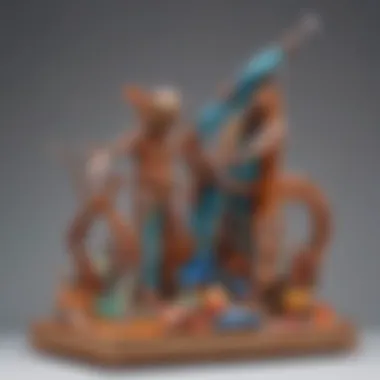
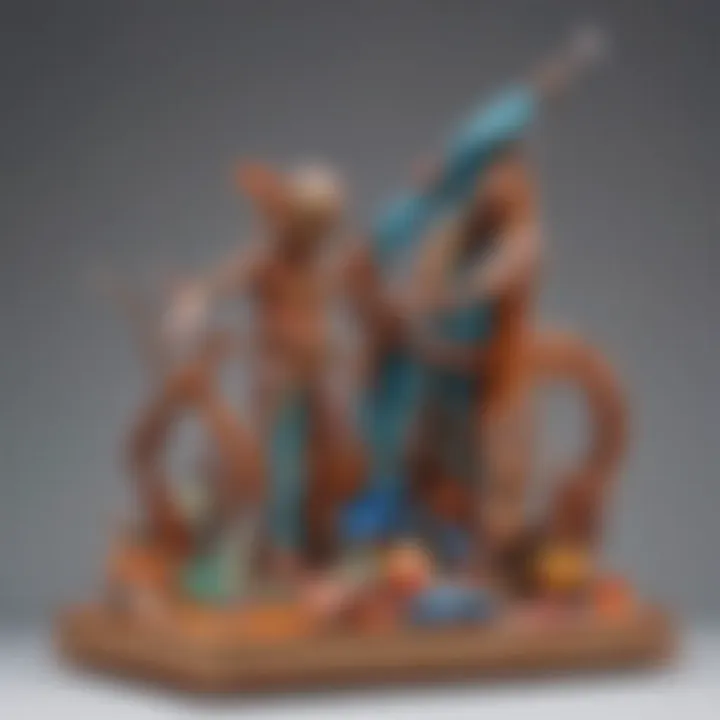
Teaching children about sustainability while they create is a timely endeavor. Recycled art projects not only encourage ecological responsibility but also ignite creativity as kids learn to see potential in what might otherwise be discarded. Using materials like plastic bottles, broken toys, or old magazines, students can fabricate anything from sculptures to functional art pieces.
Benefits of Recycled Art Projects:
- Raises awareness about environmental issues
- Encourages resourcefulness and inventiveness
- Can be a cost-effective way to gather materials for art
A great project could involve designing a robot from recycled materials, which would get the kids thinking about engineering while they have fun. Plus, they learn that waste can have a second life!
In summary, offering a range of art projects helps fourth graders not only express themselves but also connect with broader concepts from culture to sustainability. All these facets make art an essential part of their educational journey.
Integrating Art with Other Subjects
Integrating art with other subjects opens a wealth of opportunities for fourth graders to make connections between what they learn in class and the world around them. When students see how art relates to subjects like science, math, and literacy, they tend to engage more deeply. Each of these connections shapes not only their understanding of artistic concepts but also reinforces skills that are crucial in other disciplines. Consequently, this interdisciplinary approach sparks curiosity and promotes a holistic view of learning.
Art and Science Connections
Art and science might seem like two sides of a coin, but they share a lot more than one might think. For fourth graders, exploring the intersection of these subjects can lead to exciting discoveries. For instance, students can create nature journals, where they draw and describe local plants and animals. This practice not only hones their drawing skills but also enriches their understanding of biology and ecology.
Incorporating visual arts into science lessons can help students grasp complex concepts visually. Projects such as creating model ecosystems or designing a solar system can provide hands-on learning experiences. Students can engage in scientific observations while applying artistic skills, thus enhancing both their scientific understanding and creativity.
"Art encourages students to explore, experiment, and express, which is at the heart of the scientific method."
Mathematics and Art
Math and art can blend seamlessly, providing a reason for students to explore geometric shapes, symmetry, and measurements in a fun way. For example, consider a mosaic project where children create art using tiles or paper cut-outs. This not only fosters creativity but also teaches them about angles, patterns, and spatial relationships.
Using art to teach fractions can be effective as well. Students can work on projects that involve dividing shapes, like drawing a pizza or a cake, and then coloring in specific fractions. This tactile experience helps them grasp abstract math concepts solidly. Furthermore, exploring pattern designs in various art forms, such as mandalas or textile designs, can initiate discussions on repetition and sequences.
Storytelling Through Art
Art can be a powerful means of storytelling, especially for the imaginative minds of fourth graders. When they create illustrations for their stories, they engage with both art and literacy in a dynamic way. One can encourage them to draw scenes from their favorite books, or better yet, to illustrate their own narratives. This roundabout method hones their writing skills while letting them express themselves artistically.
Additionally, teacher-led discussions about how different cultures use art to tell stories can deepen students' appreciation for diversity. Projects such as creating their own comic strips or storyboards can motivate students to communicate ideas visually.
It naturally fosters a narrative approach to art that transcends mere aesthetics, allowing children to reflect on their experiences and share their thoughts in unique ways.
Encouraging Creativity in Young Artists
Encouraging creativity in young artists is not just an aesthetic endeavor, it’s a vital part of their growth and development. As fourth graders stand at the crossroads of childhood and adolescence, they’re bursting with ideas but can struggle to translate their thoughts into tangible forms of art. When educators and caregivers provide a nurturing environment that embraces their creative potentials, children begin to develop self-confidence, critical thinking, and emotional intelligence. This article focuses on how we can foster this important aspect of their learning experience.
Providing Freedom of Expression
Freedom of expression in art allows children to explore their feelings, ideas, and perspectives without confinement. Each child has a unique worldview, and art becomes a vehicle for them to communicate what’s within.
By offering varied mediums such as paint, clay, or digital platforms, you enable students to choose methods that resonate with them personally. This autonomy fosters a sense of ownership over their work, which is crucial. It’s like striking gold when kids realize they can create something cool all on their own.
Benefits of Freedom of Expression:
- Allows for personal connection to projects, making each creation meaningful.
- Enhances problem-solving skills as children navigate their artistic process.
- Encourages a lifelong love for creative endeavors.
It's equally important to avoid over-structuring projects. While guidance is necessary, the creativity can wane when too many rules dictate how to make art. So let them run wild with the paint or experiment with odd recyclables. In this way, their imagination will flourish.
Fostering Collaborative Art Projects
Engaging in collaborative art projects is another stellar approach to enhance creativity. Working with peers on a single art piece teaches children invaluable interpersonal skills. They learn the art of negotiation, compromise, and shared responsibility.
When kids gather around a large canvas or even a wall mural, they are not only creating art but also building friendships and understanding diverse perspectives. Engaging in group discussions about color choices and themes can be a treasure trove of learning opportunities.
Considerations for Successful Collaboration:
- Set clear, inclusive goals that require input from everyone.
- Encourage open dialogue for sharing ideas and feedback.
- Celebrate the process over the end product to foster an environment of acceptance.
"Art is the most beautiful of all lies."
Working together allows each child's individuality to shine through, while collectively creating something greater than the sum of its parts. With collaborative art projects, students begin to realize the power of teamwork, and that making something wonderful often requires more than just one person's vision.
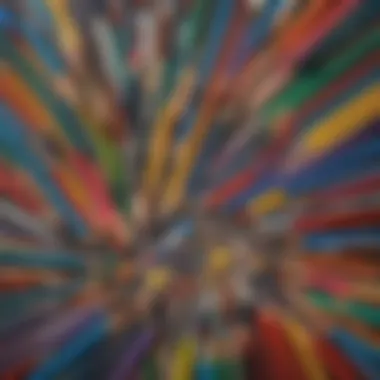

By emphasizing freedom of expression and collaboration, we sow the seeds for innovation and creativity in the ever-evolving world of young artists.
Assessing Art Projects: Approaches and Techniques
Assessing art projects in the fourth-grade level holds a significant role in helping young artists grow and develop. It’s not merely about grading the final product; rather, it encompasses a broader perspective that fosters intrinsic motivation, nurtures creativity, and enhances skills. Art assessment can inspire students by acknowledging their unique artistic expressions, which can boost their confidence and encourage future exploration in the arts.
There are various approaches when it comes to evaluation. Educators can look beyond traditional grading systems to develop a more holistic understanding of each student’s development. For instance, they might consider not only the aesthetics but also the individual process of creating an artwork.
Creating Criteria for Assessment
Establishing clear and inclusive criteria for assessment is crucial. This framework ensures that every kid’s effort and creativity are recognized. Here are a few tips for developing effective criteria:
- Identify Key Elements: Consider aspects like creativity, effort, and original ideas. What's the uniqueness of the work?
- Incorporate Self-assessment: Encourage students to reflect on their creation. Questions like "What do you like most about your work?" or "What part was most challenging?" can provide insight into their thought processes.
- Use a Rubric: Develop a simple rubric that delineates different levels of achievement—for example, "Excellent," "Good," "Satisfactory," and "Needs Improvement". This provides a clear standard while also opening up a dialogue about art as a subjective field.
“Art is not what you see, but what you make others see.” – Edgar Degas
Feedback Methods for Young Artists
Feedback plays an essential role in an aspiring artist's journey. It can shape how students view their abilities and help them refine their skills. Here are some methods that can enhance the feedback process:
- Peer Reviews: Allow students to share their work and engage with each other's projects. Constructive peer feedback can elucidate various perceptions that are beneficial for growth.
- One-on-One Discussions: Take time to individually observe each student’s art. A brief chat about what they created and their inspirations adds a personal touch and shows them that their work is valued.
- Positive Reinforcement: Emphasize strengths before discussing areas for improvement. Positive words can motivate young artists to strive for enhancement without feeling discouraged.
In summary, the assessment of art projects not only helps in monitoring the progress of young artists but also in enriching their overall education experience. The approach can be varied based on individual needs and classroom dynamics, and it ultimately supports an enduring appreciation for art as a vital component of a well-rounded education.
Showcasing Student Art
Showcasing student art serves numerous vital functions in both the educational landscape and the development of young learners. It not only allows students to take pride in their creations but also fosters a sense of belonging within the school community. Displaying artwork can spark discussions among peers and encourage engagement, making the art room a hub of creativity and inspiration. Through exhibition, young artists receive recognition, which can stoke their passion for the arts, encouraging further exploration and innovation.
Organizing Art Exhibitions
To effectively organize an art exhibition, certain elements should be taken into account. First, it's important to pick the right venue. A school gymnasium or cafeteria can be transformed into a vibrant gallery with some creativity regarding layout and design. Here are a few steps to consider:
- Theme Selection: Choose a theme that resonates with the fourth graders’ experiences or curriculums, such as "Our Impressions of Nature" or "The Cultures of the World."
- Inviting Participation: Encourage all students to submit their work. This could include paintings, drawings, sculptures, and even digital art.
- Setting Up the Space: Arrange the artwork thoughtfully. Group pieces by grade, class, or theme to provide context. Use string lights or colorful paper to create an inviting atmosphere.
- Opening Reception: Host an event where families and friends can view the artwork. This not only promotes the students’ work but also strengthens community ties.
- Feedback Opportunities: Provide simple feedback forms at the exhibition for attendees to comment on their favorite pieces, which can be rewarding for the young artists.
By following these steps, the exhibition can become a memorable experience for students, amplifying their self-esteem and nurturing their love for art.
Using Digital Platforms for Sharing Art
In this era of technology, leveraging digital platforms to showcase student art adds another dimension to the art-sharing experience. Online galleries and social media can effectively reach wider audiences. Here’s how you can put it into action:
- Creation of Online Galleries: Schools can create a dedicated webpage to display student artwork. This webpage can be shared with parents and community members, showcasing all the creativity generated in the classroom.
- Social Media Engagement: Platforms like Facebook or Instagram can serve as venues for showcasing student art. Teachers can set up a page or use existing school accounts to post images of completed projects, making sure to obtain appropriate permissions and respect privacy.
- Virtual Exhibitions: Especially relevant in today’s context, virtual exhibitions can feature videos of students talking about their works, creating an interactive viewing experience for families who cannot attend physical shows.
"Art is a way for children to communicate their feelings, perceptions, and interpretations of the world around them. Sharing this in visible formats elevates their voices."
Through these approaches, not only does student art reach a broader audience, but it also instills a sense of accomplishment and validation in young artists, igniting their creative fires.
Showcasing their work, whether in physical or digital form, is essential to helping young artists believe in their capabilities and express their unique visions.
Culmination: The Lasting Impact of Art Education
Art education plays a vital role in shaping a child’s development, particularly in the fourth grade, where children are on the brink of adolescence. Engaging in artistic activities goes beyond creating pretty pictures or crafting unique sculptures; it molds their cognitive, emotional, and social skills as well. The projects discussed in this article serve as a bridge connecting students to deeper learning and self-exploration.
A key aspect easily overlooked is how art helps in developing perseverance. When students work on a craft or draw a complex image, they often face challenges. They may not get it right the first time, but through practice, they learn to adapt and try again. This resilience is invaluable, as it will benefit them in future academic and personal endeavors. Moreover, art engages the senses, fostering a better understanding of the world around them. Through exploration of colors, textures, and shapes, fourthed graders can communicate experiences and emotions more effectively than through words alone.
"Art allows children to express what they sometimes can't put into words, opening doors to deeper emotional connections and understanding."
Long-Term Benefits of Artistic Engagement
Engagement in art projects nurtures critical thinking and problem-solving abilities, a fundamental cornerstone in education. Fourth graders participating in these initiatives develop a unique process for interpreting and making sense of their experiences. They learn to analyze situations, weigh options, and come to conclusions based on their artistic explorations.
Long-standing academic research reveals that children engaged in the arts perform better on standardized tests and exhibit heightened levels of creativity. As they progress through school, these skills become more apparent:
- Enhanced creativity: Collaborating on projects or brainstorming new ideas helps students think outside the box.
- Improved academic performance: The absorption of art into education often correlates with better performance in subjects like math and science due to interconnections in thought processes.
- Deeper emotional insight: Expressing feelings through art allows children to understand their emotions and navigate social situations better.
Encouraging Future Art Involvement
To ensure that children continue to explore and appreciate art, fostering a rich environment filled with opportunities is critical. Parents, teachers, and community leaders can work together to create more avenues for young artists. Here are some ways to encourage ongoing involvement in the arts:
- Create accessible art spaces: Community centers and schools should provide spaces where children can explore art freely. A corner with art supplies could inspire young minds.
- Host community art events: By organizing festivals or exhibitions, children can showcase their work and feel valued. This not only boosts their confidence but also fosters a sense of belonging.
- Integrate art into daily activities: Art doesn’t have to be constrained to formal lessons. Encourage children to draw, paint, or craft during their personal time, whether at home or when outdoors.
- Utilize technology: Digital platforms can offer new creative outlets. There are various apps that allow children to create digital art, providing an alternative to traditional methods.
